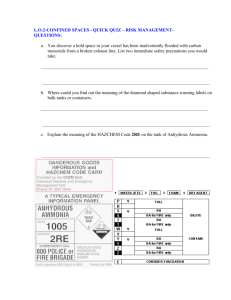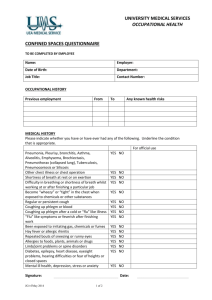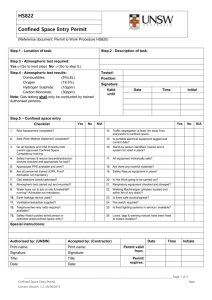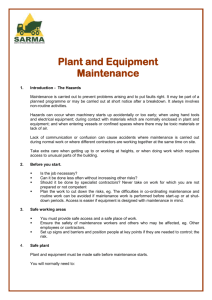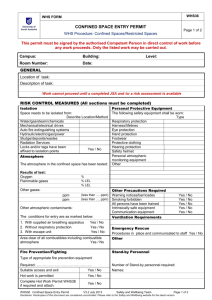The University of Montana Safety Manual - Chapter 10
advertisement
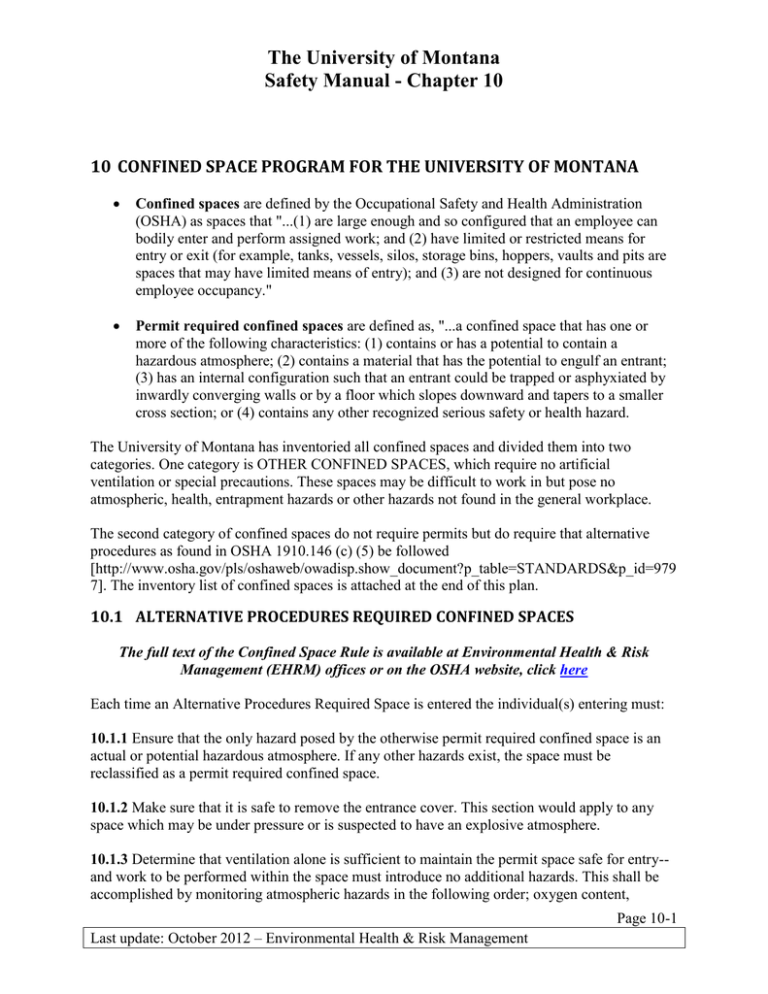
The University of Montana Safety Manual - Chapter 10 10 CONFINED SPACE PROGRAM FOR THE UNIVERSITY OF MONTANA Confined spaces are defined by the Occupational Safety and Health Administration (OSHA) as spaces that "...(1) are large enough and so configured that an employee can bodily enter and perform assigned work; and (2) have limited or restricted means for entry or exit (for example, tanks, vessels, silos, storage bins, hoppers, vaults and pits are spaces that may have limited means of entry); and (3) are not designed for continuous employee occupancy." Permit required confined spaces are defined as, "...a confined space that has one or more of the following characteristics: (1) contains or has a potential to contain a hazardous atmosphere; (2) contains a material that has the potential to engulf an entrant; (3) has an internal configuration such that an entrant could be trapped or asphyxiated by inwardly converging walls or by a floor which slopes downward and tapers to a smaller cross section; or (4) contains any other recognized serious safety or health hazard. The University of Montana has inventoried all confined spaces and divided them into two categories. One category is OTHER CONFINED SPACES, which require no artificial ventilation or special precautions. These spaces may be difficult to work in but pose no atmospheric, health, entrapment hazards or other hazards not found in the general workplace. The second category of confined spaces do not require permits but do require that alternative procedures as found in OSHA 1910.146 (c) (5) be followed [http://www.osha.gov/pls/oshaweb/owadisp.show_document?p_table=STANDARDS&p_id=979 7]. The inventory list of confined spaces is attached at the end of this plan. 10.1 ALTERNATIVE PROCEDURES REQUIRED CONFINED SPACES The full text of the Confined Space Rule is available at Environmental Health & Risk Management (EHRM) offices or on the OSHA website, click here Each time an Alternative Procedures Required Space is entered the individual(s) entering must: 10.1.1 Ensure that the only hazard posed by the otherwise permit required confined space is an actual or potential hazardous atmosphere. If any other hazards exist, the space must be reclassified as a permit required confined space. 10.1.2 Make sure that it is safe to remove the entrance cover. This section would apply to any space which may be under pressure or is suspected to have an explosive atmosphere. 10.1.3 Determine that ventilation alone is sufficient to maintain the permit space safe for entry-and work to be performed within the space must introduce no additional hazards. This shall be accomplished by monitoring atmospheric hazards in the following order; oxygen content, Page 10-1 Last update: October 2012 – Environmental Health & Risk Management The University of Montana Safety Manual - Chapter 10 flammable gases and vapors and finally, potential toxic air contaminants. Atmospheric testing must be done prior to and without entering the space. If initial monitoring found no evidence of flammable gases or vapors and if the permit space is not normally expected to present the hazards posed by such gases and vapors, no further testing is necessary. If flammable gas is initially detected, continuous monitoring must be done. 10.1.4 The test data in (3) above must be documented, retained and available to employees. The verification must be in the form of a certification that contains the date, the location of the space, and the signature of the certifying individual all of which is made available to the entrants. This certification documents the employers compliance efforts. The certificate must be retained by the Department supervisor for at least one year from entry date. Entry may take place after: a. It has been determined safe to remove the cover; b. Any openings are guarded to protect against falling in or falling objects; c. Internal atmospheric testing shows no unexpected hazards; d. Continuous forced air ventilation has eliminated any hazardous atmosphere; e. The air remains without hazard whenever any employee is inside the space; f. The atmosphere is tested periodically. Employees must exit immediately if a hazardous atmosphere is detected during entry, and the space must be evaluated to determine how the hazardous atmosphere developed. If there is any question about the safety of a space or you cannot determine that conditions are safe to enter ANY space, contact your supervisor or the Environmental Health & Risk Management (EHRM) Office. 10.2 TRAINING REQUIREMENTS The standard requires that: 10.2.1 The employer shall provide training so that all employees whose work is regulated under this section acquire the understanding, knowledge, and skills necessary for the safe performance of the duties assigned under this section. 10.2.2 Training shall be provided to each affected employee: Page 10-2 Last update: October 2012 – Environmental Health & Risk Management The University of Montana Safety Manual - Chapter 10 (i) Before the employee is first assigned duties; (ii) Before there is a change in assigned duties; (iii) Whenever there is a change in permit space operations that presents a hazard about which the employee has not been previously trained; 10.2.3 The training shall establish employee proficiency in the duties required by this section and shall introduce new or revised procedures, as necessary, for compliance with this section. 10.2.4 The employer shall certify that the training required by this section has been accomplished. This certification shall contain each employees name, the signatures or initials of the trainers and the dates of the training. The certification shall be available for inspection by employees and their authorized representatives. The training certificate must be retained by the Department. 10.3 UNIVERSITY OF MONTANA TRAINING At this time, The University has no permit required confined spaces that pose hazards other than atmospheric. This means that the full permit required confined space program is not necessary but that we must still follow the alternative procedures portion of the rule. Individuals who will enter spaces requiring alternative procedures should still be familiar with the full permit required program and will be trained as follows: VIDEO TAPES entitled Confined Space Entry-A Survival Guide Parts one and two will be used to provide a general overview of the confined space program. The two tapes are about 33 minutes and are available as a loan from Environmental Health and Risk Management. A TEST follows the tapes and can be taken at the employees or supervisors convenience. AMBIENT AIR MONITORS for atmospheric gases are stored in and calibrated by Environmental Health. Training shall include the use and interpretation of the available instrumentation. DOCUMENTATION of all monitoring results must be recorded. Training in proper documentation and retention of records must be included. CONFINED SPACE TRAINING CERTIFICATION FORMS and ATMOSPHERIC MONITORING CERTIFICATION FORMS ARE AVAILABLE FROM EHRM. Page 10-3 Last update: October 2012 – Environmental Health & Risk Management The University of Montana Safety Manual - Chapter 10 10.4 CONFINED SPACE INVENTORY for The University of Montana 10.4.1 ARTIFICIAL VENTILATION REQUIRED CONFINED SPACE Alternative Procedures Required 1. All sewer manholes 2. Crawlspace beneath Main Hall (Will use negative pressure ventilation) 3. Forestry sump at the west end of the building. 4. Sewage ejectors 5. Pit for motor pool sewer main and clean outs for oil sand separators. 10.4.2 OTHER CONFINED SPACES Artificial Ventilation Not Required 1. Above ceiling of Lodge 2. Irrigation manholes 3. Boilers, provided lock out tag out is followed and they are ventilated. 4. Water meter pits 5. Overhang in Science Complex 6. Sump pit at PARTV--We will want to monitor this over the next few entries to verify 7. Garbage chutes 8. Pool manhole in corridor 9. Social Science irrigation pit on east side 10. Forestry Greenhouse pit tunnel access 11. Meter pit north of Brantly 12. Elevator shafts 13. Pool tunnels 14. Schrieber Gym tunnels- pipe chase from rm 110 15. Crawl spaces-Lodge, Turner 16. Tunnel around Facilities 17. Pharm-Psyc penthouse-SA-1 ductwork 18. Cooling tower sumps at UC, Pharm Psyc., Library, PARTV, Law, Social Science and the Lodge. These would not be permit required for Tech Services but may be for painters who are spraying inside the towers. We will need to evaluate this the next time one is painted. 19. Old law building tunnel 20. 1325 Gerald crawl space 21. Fine Arts, University Theater air handlers. 22. Craig Hall west wing still has unabated asbestos. Entry would require full asbestos procedures. 23. Family Housing-dirt crawl spaces under the X's 24. Turner Hall- dirt crawl spaces 25. Duniway Hall- dirt crawl spaces Page 10-4 Last update: October 2012 – Environmental Health & Risk Management
